Characteristics and Causes of Extremely Persistent Heavy Rainfall of Tropical Cyclone In-Fa (2021)
Abstract
:1. Introduction
2. Data
3. Characteristics of Persistent Heavy Precipitation
3.1. General Characteristics
3.2. Intensity and Duration
4. Causes of Persistent Precipitation in Zhejiang and Jiangsu
4.1. Largescale Environmental Conditions and the TC’s Slow Movement
4.2. The TC’s Circulation Maintenance
4.3. Dynamic Water Vapor Conditions and Topographic Effects in Zhejiang
4.4. Persistent Dynamic and Thermal Conditions in Jiangsu
5. Conclusions
Author Contributions
Funding
Institutional Review Board Statement
Informed Consent Statement
Data Availability Statement
Conflicts of Interest
References
- Yang, L.; Liu, M.; Smith, J.A.; Tian, F. Typhoon Nina and the August 1975 Flood over Central China. J. Hydrometeorol. 2017, 18, 451–472. [Google Scholar] [CrossRef]
- Zhang, S.Q.; Zupanski, M.; Hou, A.Y.; Lin, X.; Cheung, S.H. Assimilation of precipitation-affected radiances in a cloud-resolving WRF ensemble data assimilation system. Mon. Weather. Rev. 2013, 141, 754–772. [Google Scholar] [CrossRef] [Green Version]
- Chang, C.-P.; Lei, Y.; Sui, C.-H.; Lin, X.; Ren, F. Tropical cyclone and extreme rainfall trends in East Asian summer monsoon since mid-20th century. Geophys. Res. Lett. 2012, 39. [Google Scholar] [CrossRef]
- Zhang, Q.; Wu, L.; Liu, Q. Tropical cyclone damages in China 1983–2006. Bull. Am. Meteorol. Soc. 2009, 90, 489–496. [Google Scholar] [CrossRef] [Green Version]
- Quesada-Román, A.; Villalobos-Chacón, A. Flash flood impacts of Hurricane Otto and hydrometeorological risk mapping in Costa Rica. Geogr. Tidsskr. J. Geogr. 2020, 120, 142–155. [Google Scholar] [CrossRef]
- Ge, X.; Li, T.; Zhang, S.; Peng, M. What causes the extremely heavy rainfall in Taiwan during Typhoon Morakot (2009)? Atmos. Sci. Lett. 2010, 11, 46–50. [Google Scholar] [CrossRef]
- Chen, L.; Li, Y.; Cheng, Z. An overview of research and forecasting on rainfall associated with landfalling tropical cyclones. Adv. Atmos. Sci. 2010, 27, 967–976. [Google Scholar] [CrossRef]
- Sun, W.; Xu, Y. Assimilation of FY-3D MWHS-2 Radiances with WRF Hybrid-3DVAR System for the Forecast of Heavy Rainfall Evolution Associated with Typhoon Ampil. Mon. Weather Rew. 2021, 149, 1419–1437. [Google Scholar] [CrossRef]
- Yen, T.-H.; Wu, C.-C.; Lien, G.-Y. Rainfall Simulations of Typhoon Morakot with Controlled Translation Speed Based on EnKF Data Assimilation. Terr. Atmos. Ocean. Sci. 2011, 22, 647–660. [Google Scholar] [CrossRef] [Green Version]
- Wu, R.; Wu, S.; Chen, T.; Yang, Q.; Han, B.; Zhang, H. Effects of Wave–Current Interaction on the Eastern China Coastal Waters during Super Typhoon Lekima (2019). J. Phys. Oceanogr. 2021, 51, 1611–1636. [Google Scholar] [CrossRef]
- Deng, D.; Davidson, N.E.; Hu, L.; Tory, K.J.; Hankinson, M.C.N.; Gao, S. Potential Vorticity Perspective of Vortex Structure Changes of Tropical Cyclone Bilis (2006) during a Heavy Rain Event following Landfall. Mon. Weather Rew. 2017, 145, 1875–1895. [Google Scholar] [CrossRef]
- Gao, S.; Meng, Z.; Zhang, F.; Bosart, L.F. Observational Analysis of Heavy Rainfall Mechanisms Associated with Severe Tropical Storm Bilis (2006) after Its Landfall. Mon. Weather Rev. 2009, 137, 1881–1897. [Google Scholar] [CrossRef]
- Li, Y.; Chen, L. Numerical study on impact of the boundary layer fluxes over wetland on sustention and rainfall of landfalling tropical cyclones. Acta Meteorol. Sin. 2007, 21, 34–46. [Google Scholar]
- Zhu, H.; Yang, Z.; Wang, D.; Yu, J. Comparative analysis of the rainstorms caused by two typhoons in inland China. Acta Meteorol. Sin. 2019, 77, 268–281. (In Chinese) [Google Scholar]
- Wu, L.; Liang, J.; Wu, C.C. Monsoonal influence on typhoon Morakot (2009). Part I: Observational analysis. J. Atmos. Sci. 2011, 68, 2208–2221. [Google Scholar] [CrossRef]
- Hong, C.-C.; Lee, M.-Y.; Hsu, H.-H.; Kuo, J.-L. Role of submonthly disturbance and 40–50 day ISO on the extreme rainfall event associated with Typhoon Morakot (2009) in Southern Taiwan. Geophys. Res. Lett. 2010, 37. [Google Scholar] [CrossRef] [Green Version]
- Wang, C.-C.; Kuo, H.-C.; Chen, Y.-H.; Huang, H.-L.; Chung, C.-H.; Tsuboki, K. Effects of Asymmetric Latent Heating on Typhoon Movement Crossing Taiwan: The Case of Morakot (2009) with Extreme Rainfall. J. Atmos. Sci. 2012, 69, 3172–3196. [Google Scholar] [CrossRef]
- Doswell III, C.A.; Brooks, H.E.; Maddox, R.A. Flashflood forecasting: An ingredients-based methodology. Weather Forecast. 1996, 11, 560–581. [Google Scholar] [CrossRef]
- Xu, Y.M. The numerical study of landfalling Typhoon Bill (1988): Inner core structures and budgets of energy and moisture. Acta Meteorol. Sin. 2007, 65, 877–887. (In Chinese) [Google Scholar]
- Dong, M.; Chen, L.; Li, Y.; Lu, C. Rainfall Reinforcement Associated with Landfalling Tropical Cyclones. J. Atmos. Sci. 2010, 67, 3541–3558. [Google Scholar] [CrossRef]
- Lei, X. The influence of diabatic heating on tropical cyclone radial inhomogeneity structure. Acta Oceanol. Sin. 2000, 22, 24–30. (In Chinese) [Google Scholar]
- Frank, W.M.; Ritchie, E.A. Effects of vertical windshear on the intensity and structure of numerically simulated hurricanes. Mon. Weather Rev. 2001, 129, 2249–2269. [Google Scholar] [CrossRef]
- Merrill, R.T. Environmental Influences on Hurricane Intensification. J. Atmos. Sci. 1988, 45, 1678–1687. [Google Scholar] [CrossRef] [Green Version]
- Chen, S.S.; Knaff, J.A.; Marks, F.D., Jr. Effects of vertical wind shear and storm motion on tropical cyclone rainfall asymmetries deduced from TRMM. Mon. Weather Rev. 2006, 134, 3190–3208. [Google Scholar] [CrossRef]
- Meng, W.; Wang, Y. A diagnostic study on heavy rainfall induced by landfalling typhoon Utor (2013) in South China: 1. Rainfall asymmetry at landfall. J. Geophys Res. 2016, 121, 12781–12802. [Google Scholar] [CrossRef]
- Meng, W.; Wang, Y. A diagnostic study on heavy rainfall induced by landfalling Typhoon Utor (2013) in South China: 2. Postlandfall rainfall. J. Geophys. Res. Atmos. 2016, 121, 12803–12819. [Google Scholar] [CrossRef] [Green Version]
- Yang, S.; Lu, Y.; Zhang, F.; Tao, Y. Analysis on causes of persistent heavy rainfall brought by tropical storm Ewiniar. Meteorol. Mon. 2021, 47, 106–116. (In Chinese) [Google Scholar]
- Fang, X.; Kuo, Y.H.; Wang, A. The Impacts of Taiwan Topography on the Predictability of Typhoon Morakot’s Record-Breaking Rainfall: A High-Resolution Ensemble Simulation. Weather Forecast. 2011, 26, 613–633. [Google Scholar] [CrossRef] [Green Version]
- Wu, C.-C.; Li, T.-H.; Huang, Y.-H. Influence of Mesoscale Topography on Tropical Cyclone Tracks: Further Examination of the Channeling Effect. J. Atmos. Sci. 2015, 72, 3032–3050. [Google Scholar] [CrossRef]
- Yang, S.; Cao, Y.; Chen, T.; Tang, J.; Guo, Y. Causes and focus points of forecasting the scattered rainstorm of Typhoon Soudelor on Day 2 after landing. Meteorol. Mon. 2019, 45, 38–49. (In Chinese) [Google Scholar]
- Sun, J.; Zhang, F. Daily extreme precipitation and trends over China. Sci. China Earth Sci. 2017, 60, 2190–2203. [Google Scholar] [CrossRef]
- Chen, K.; Li, J.; Xie, T.; Wang, Q.; Wang, L. Analysis of the spatiotemporal characteristics and trends of global atmospheric energy. Chin. J. Atmos. Sci. 2020, 44, 168–182. (In Chinese) [Google Scholar]
- Liang, L.; Wu, Z.; Yan, G. The dynamic mechanism maintaining Typhoon 9012 in active stage long after landfall. J. Trop. Meteorol. 1995, 11, 26–34. (In Chinese) [Google Scholar]
- Liu, J.; Zhou, G.; Gu, S.; Wang, Y.; Guo, J. Diagnosis of heavy rainfall associated with Typhoon Fitow. Meteorol. Sci. Technol. 2014, 42, 1047–1056. (In Chinese) [Google Scholar] [CrossRef]
- Zhou, F.; Qian, Y.; Zhu, X.; Du, K.; Jin, L. Cause analysis on the severe rainfall in Zhejiang during the weakening of Fitow. Meteorol. Mon. 2014, 40, 930–939. (In Chinese) [Google Scholar]
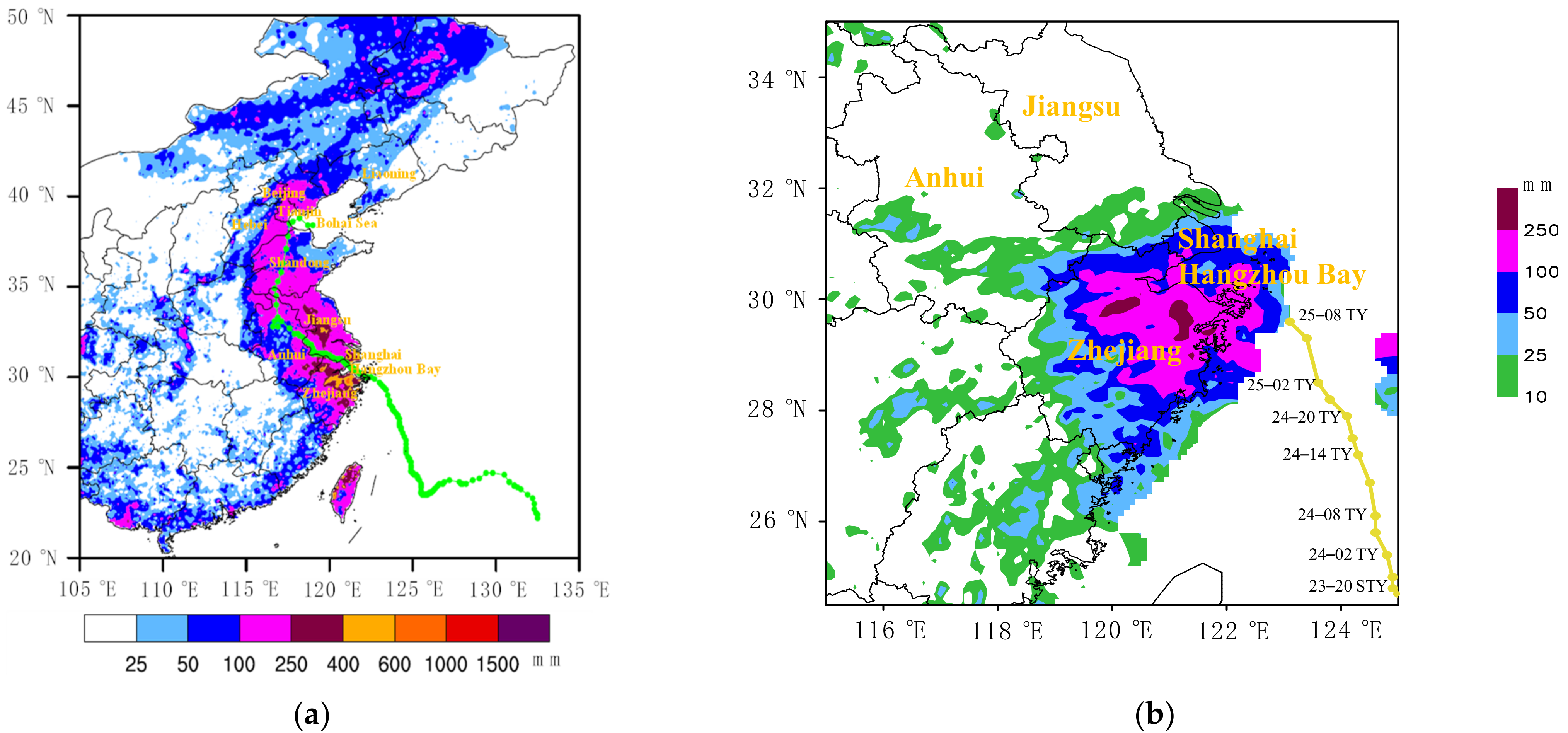
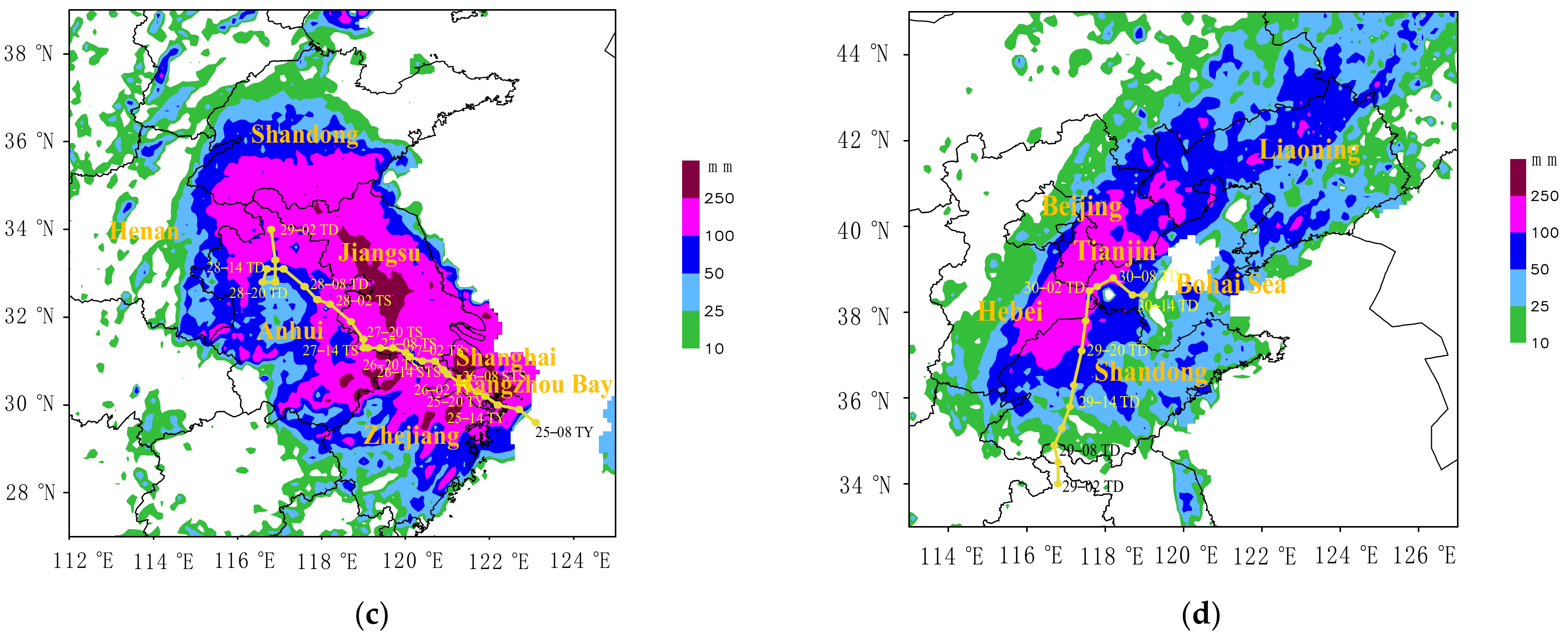


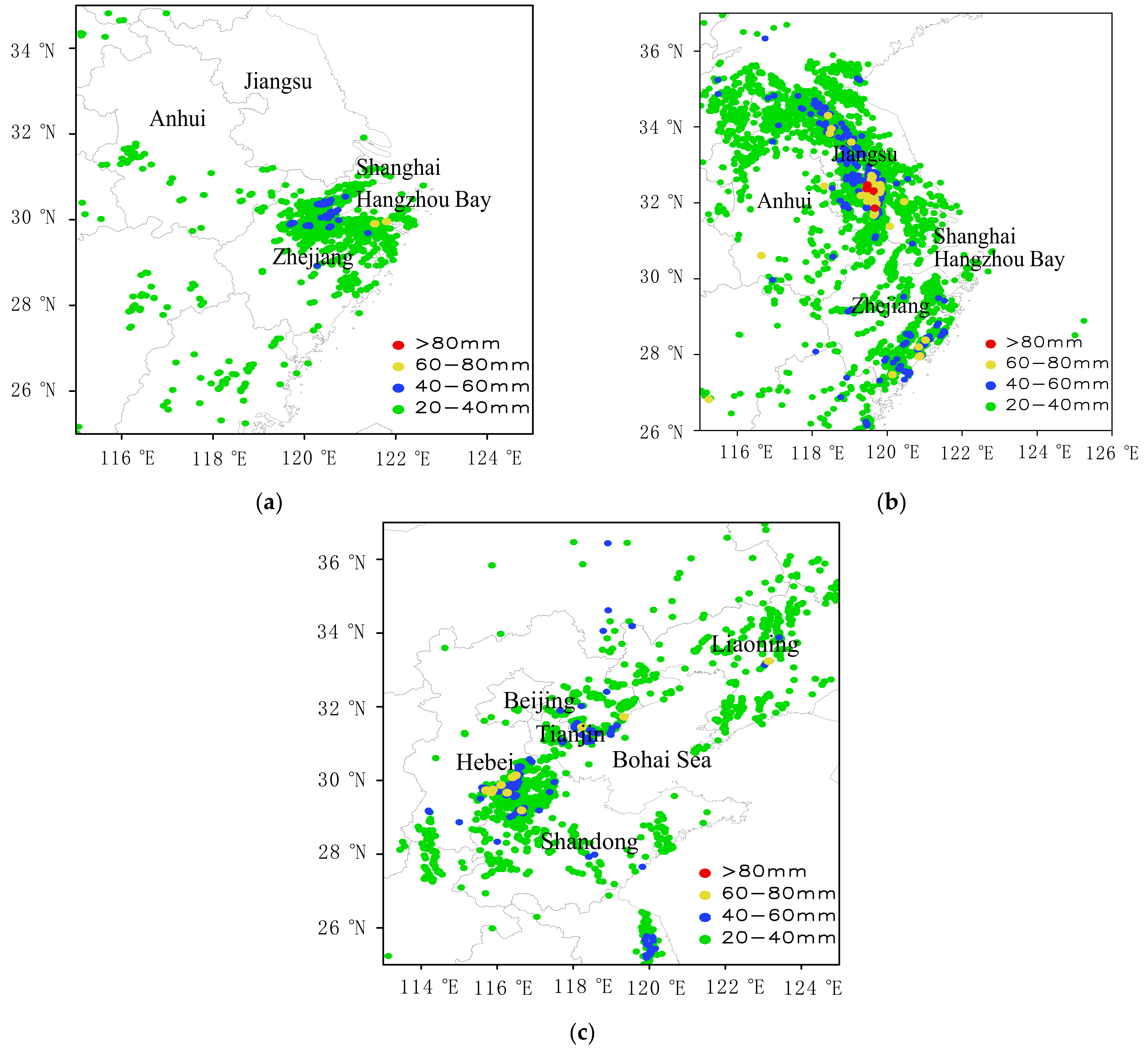
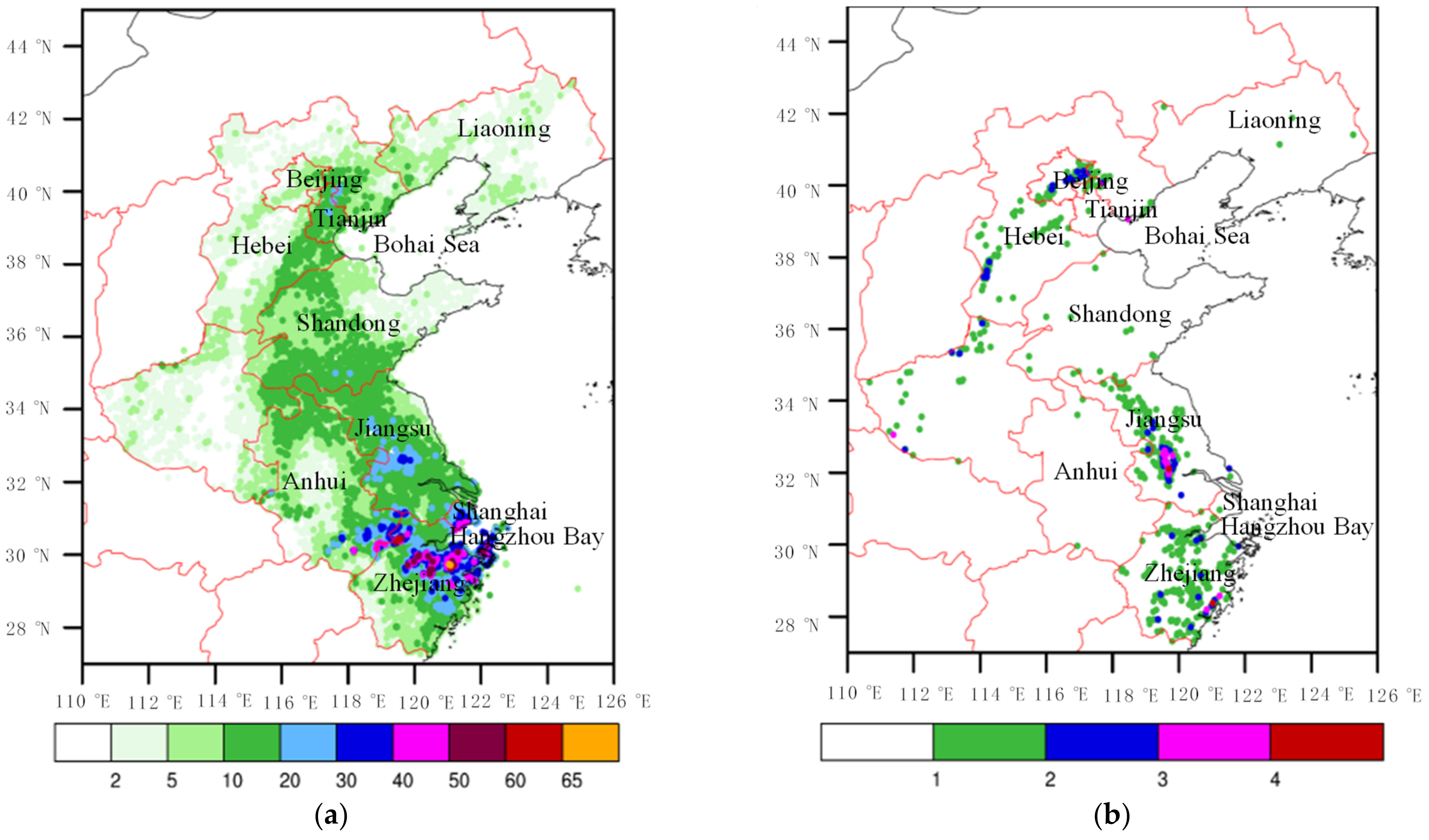
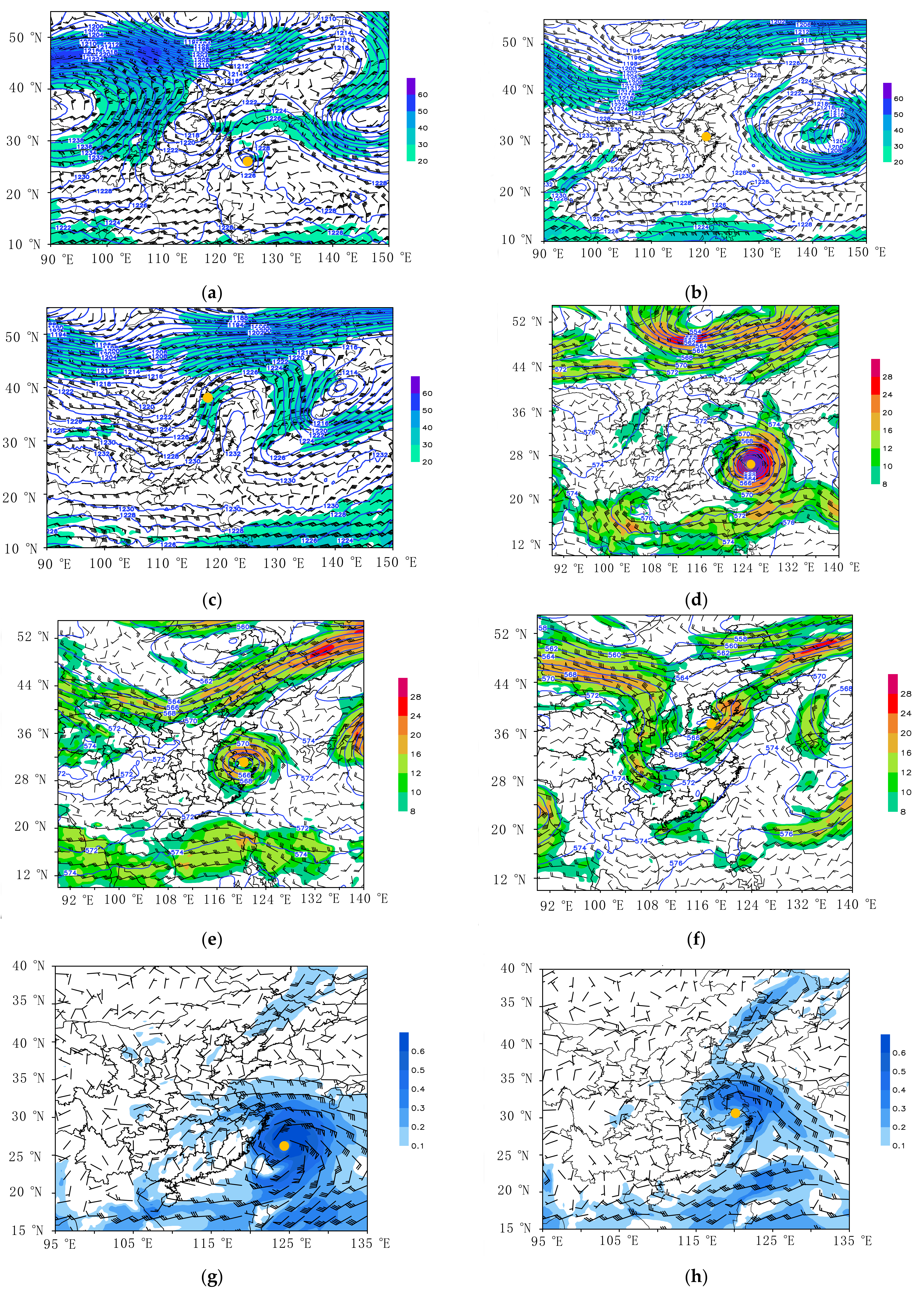
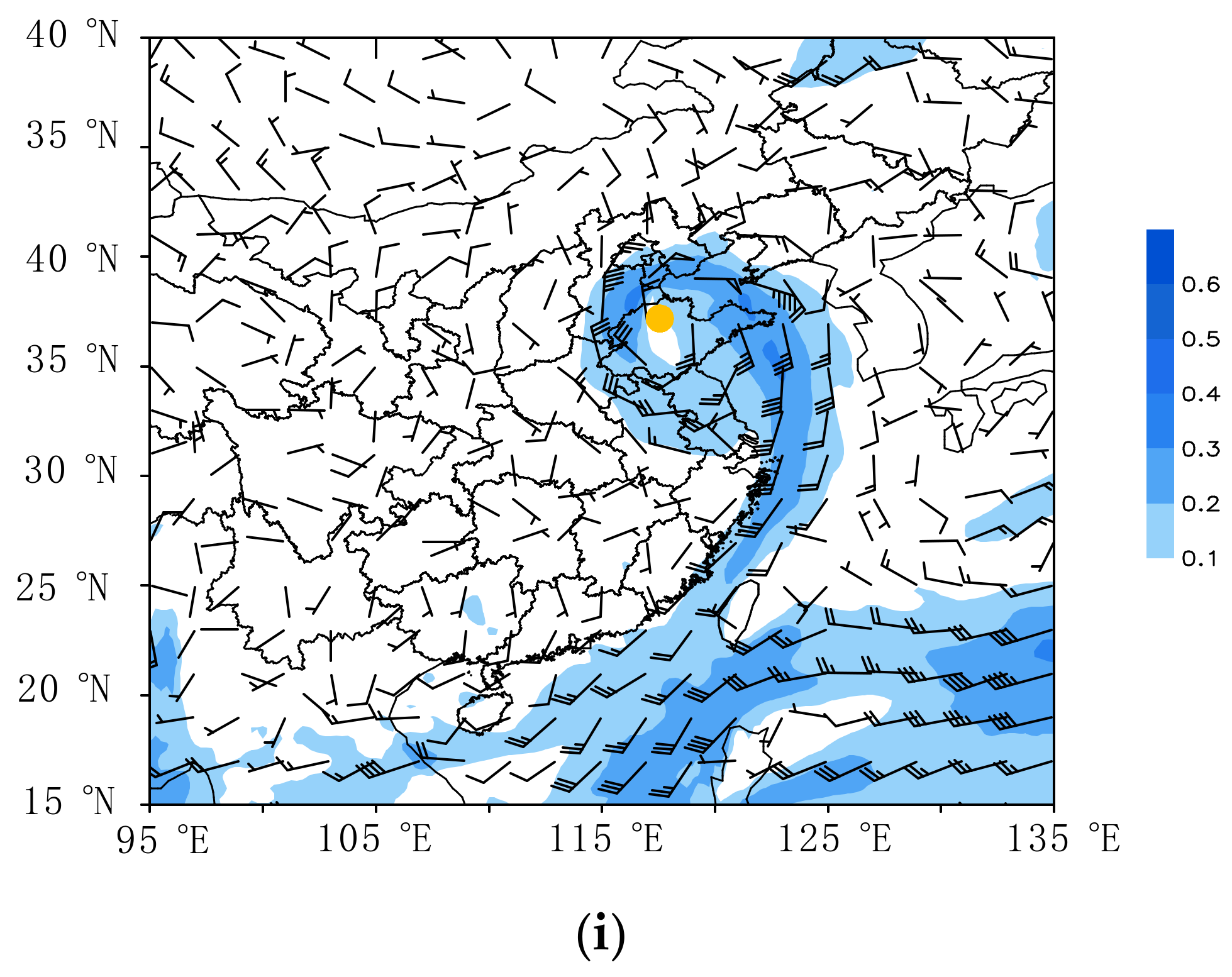
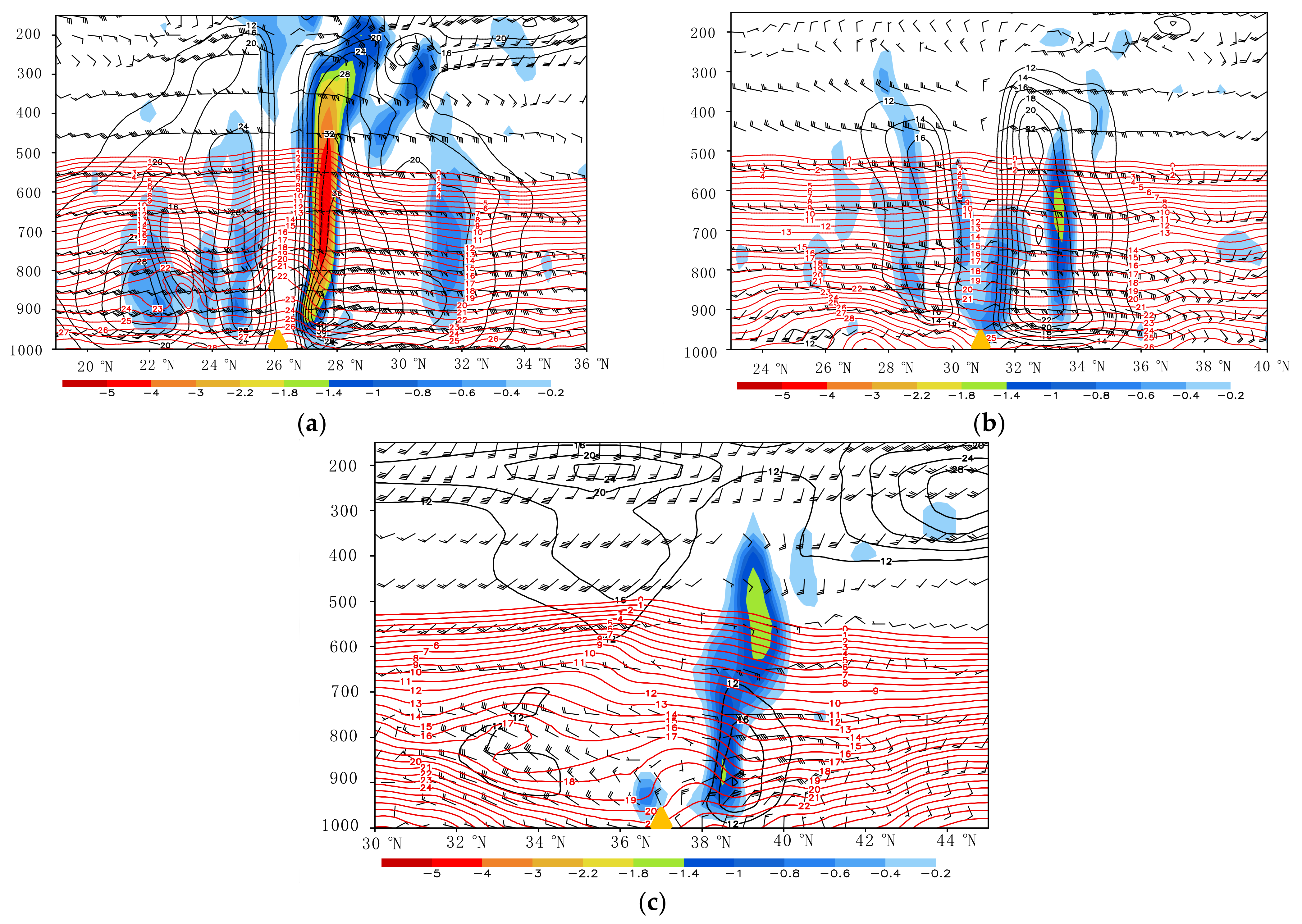


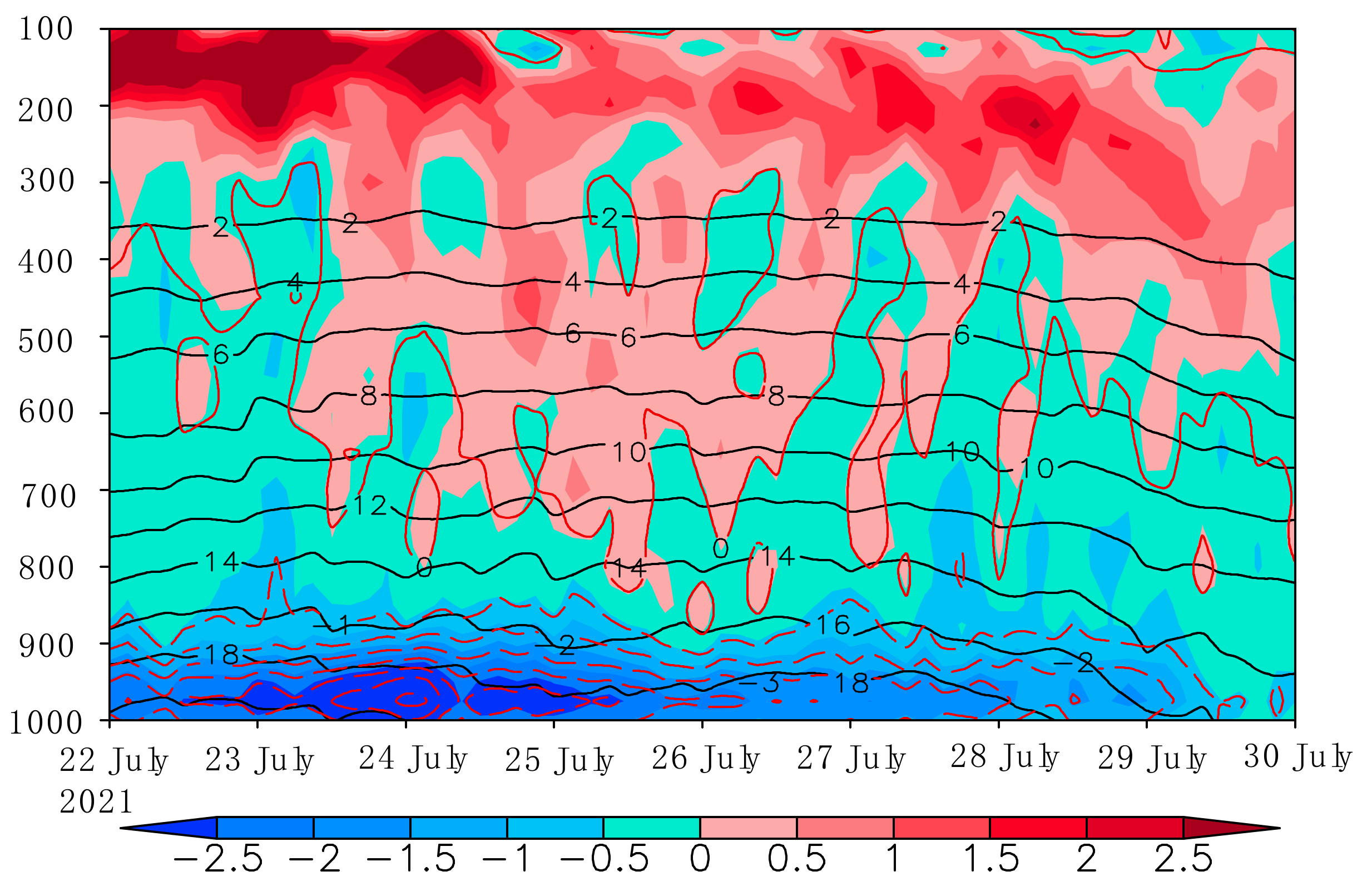
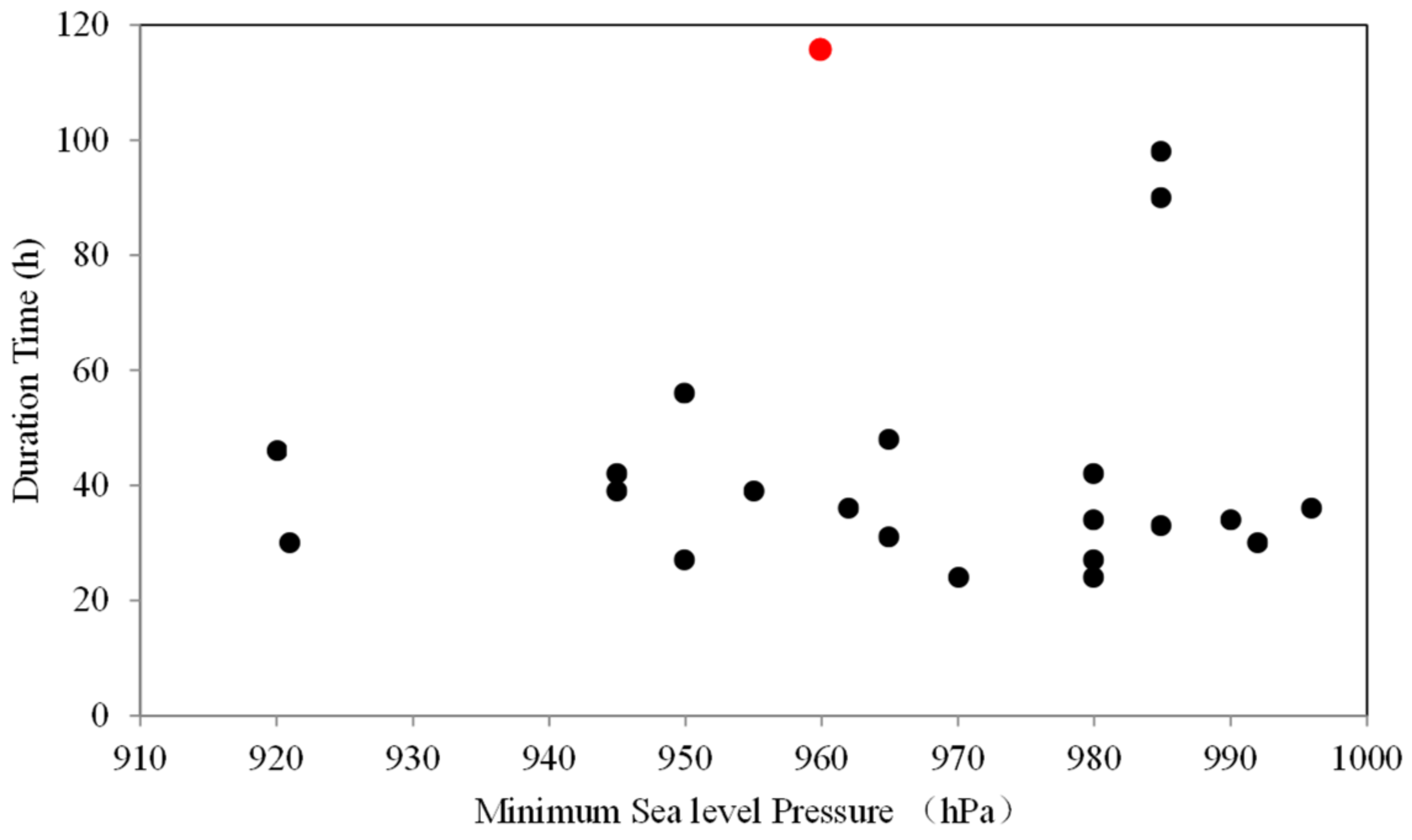
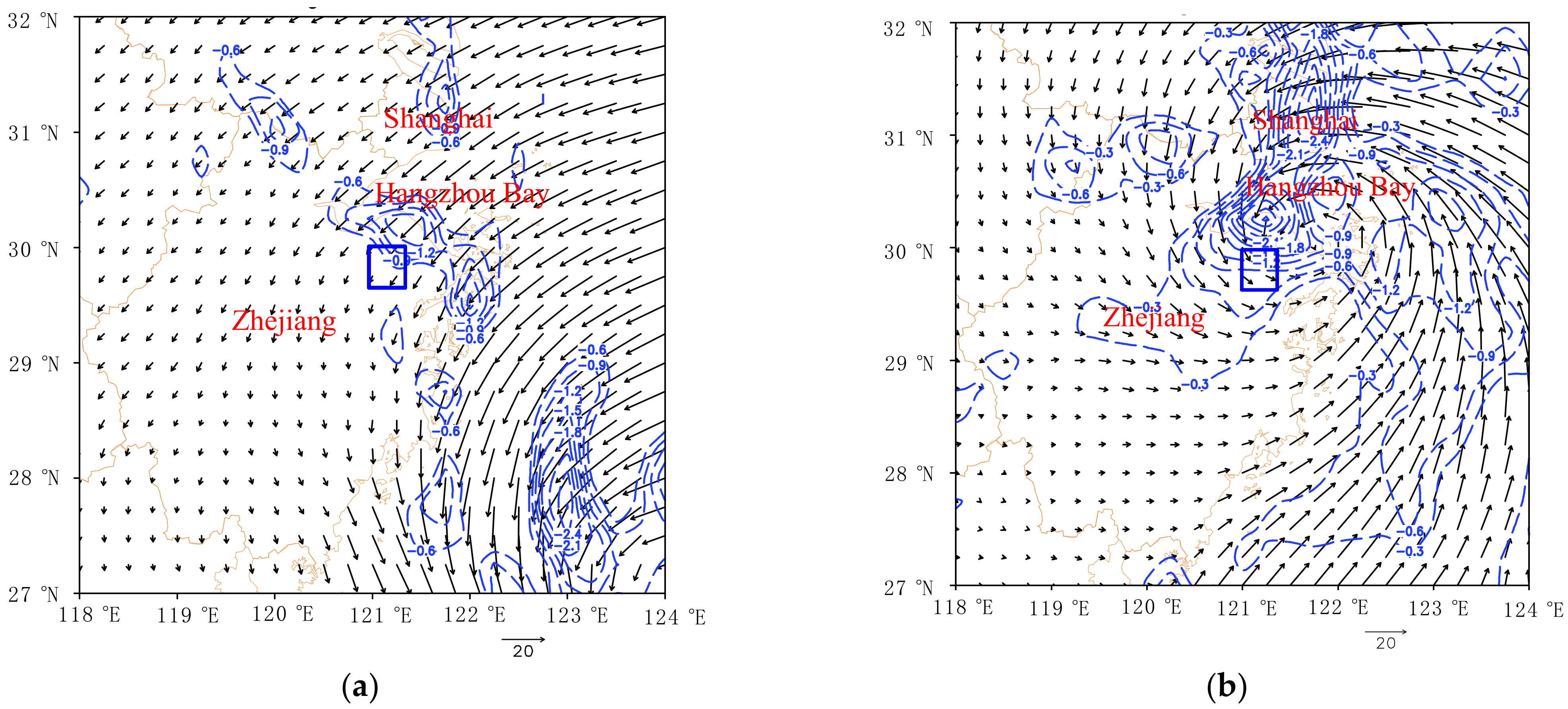
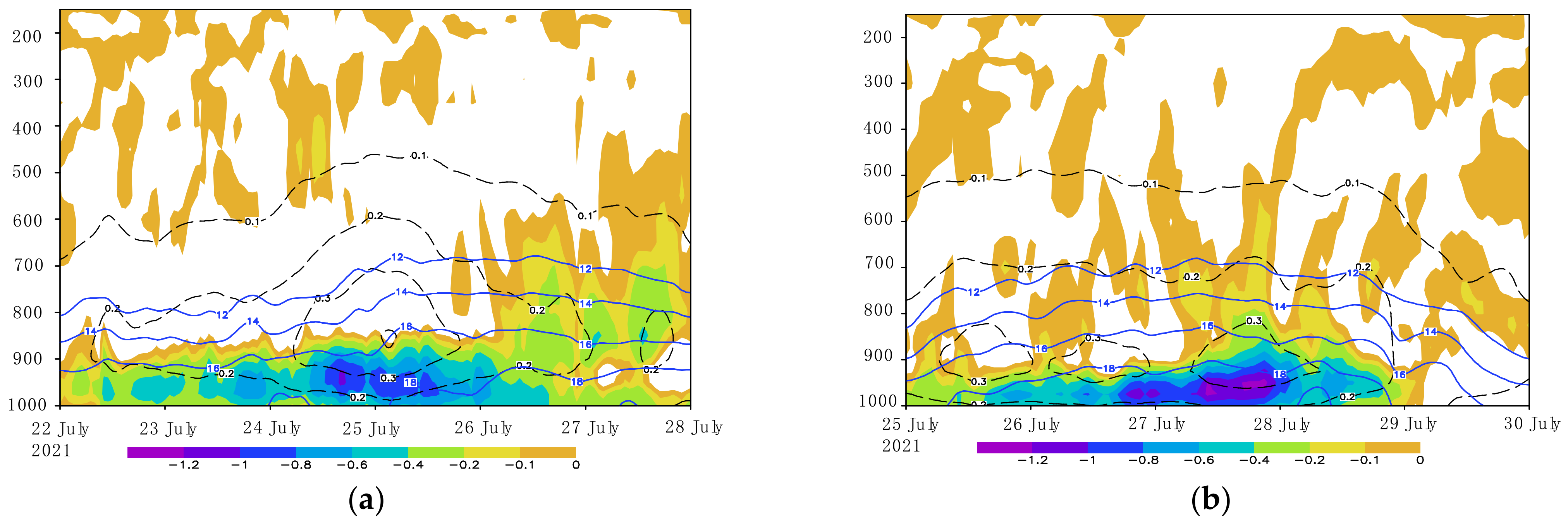
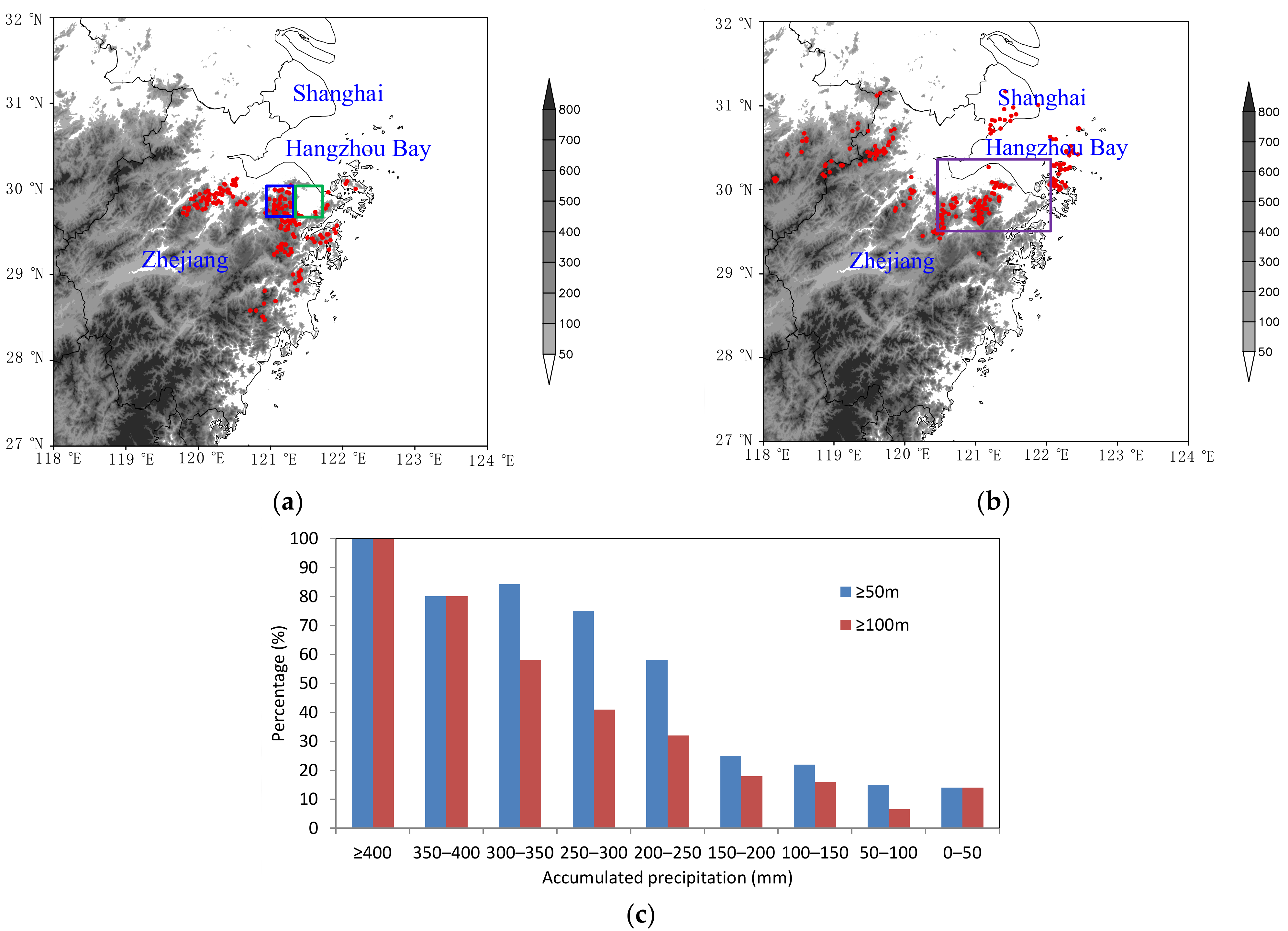


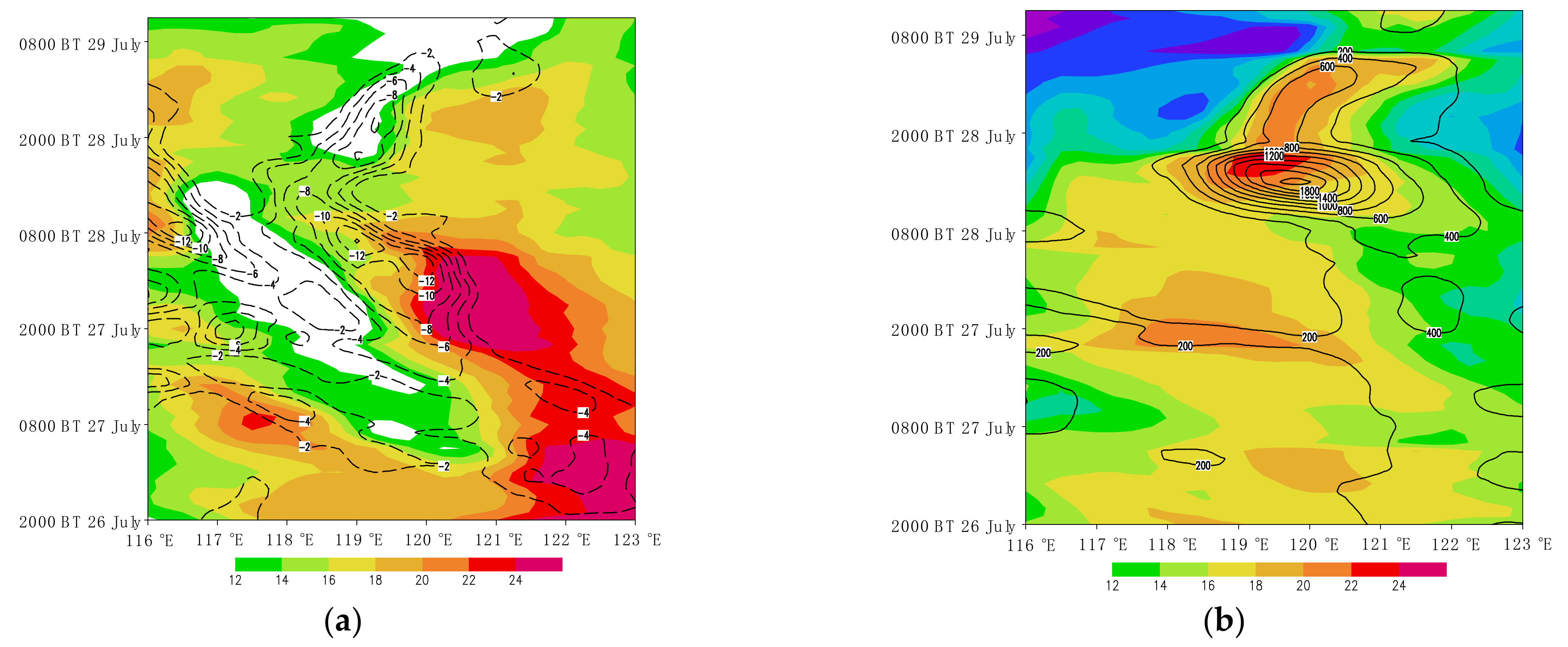
| Stations | Station SM | Station PL |
|---|---|---|
| maximum precipitation (mm) | 446 | 249 |
| minimum precipitation (mm) | 197 | 86 |
| average precipitation (mm) | 308 | 168 |
| 500-hPa wind speed (m s−1) | 10.4 | 10.5 |
| 700-hPa wind speed (m s−1) | 18 | 19.5 |
| 850-hPa wind speed (m s−1) | 18.3 | 18.4 |
| 925-hPa wind speed (m s−1) | 14.5 | 16 |
| 500-hPa specific humidity (g kg−1) | 6.2 | 6.1 |
| 700-hPa specific humidity (g kg−1) | 10.1 | 9.8 |
| 850-hPa specific humidity (g kg−1) | 13.3 | 13 |
| 925-hPa specific humidity (g kg−1) | 17.3 | 17.2 |
| 850-hPa divergence (10−5 s−1) | −0.5 | 1 |
| 925-hPa divergence (10−5 s−1) | −5 | −3 |
Publisher’s Note: MDPI stays neutral with regard to jurisdictional claims in published maps and institutional affiliations. |
© 2022 by the authors. Licensee MDPI, Basel, Switzerland. This article is an open access article distributed under the terms and conditions of the Creative Commons Attribution (CC BY) license (https://creativecommons.org/licenses/by/4.0/).
Share and Cite
Yang, S.; Chen, B.; Zhang, F.; Hu, Y. Characteristics and Causes of Extremely Persistent Heavy Rainfall of Tropical Cyclone In-Fa (2021). Atmosphere 2022, 13, 398. https://doi.org/10.3390/atmos13030398
Yang S, Chen B, Zhang F, Hu Y. Characteristics and Causes of Extremely Persistent Heavy Rainfall of Tropical Cyclone In-Fa (2021). Atmosphere. 2022; 13(3):398. https://doi.org/10.3390/atmos13030398
Chicago/Turabian StyleYang, Shunan, Boyu Chen, Fanghua Zhang, and Yi Hu. 2022. "Characteristics and Causes of Extremely Persistent Heavy Rainfall of Tropical Cyclone In-Fa (2021)" Atmosphere 13, no. 3: 398. https://doi.org/10.3390/atmos13030398





